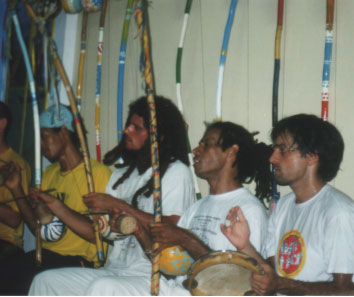
Capoeira , Dancing For Defense…
During the Portuguese colonization of Brazil , more that two million Africans were brought to the territory as slaves.
In the main they were taken to what are now the states of Pernambuco, Bahia and Rio de Janeiro. It is thought that the slaves from Angola, were the first to bring Capoeira to Brazil in the 16th century.
Capoeira was initially developed as a self-defense technique based on traditional African dance rituals. The slaves practiced during their free-time and in their living quarters , away from the pr
 ying eyes of the landowner master (often a sugar plantation).
ying eyes of the landowner master (often a sugar plantation).Whilst doing this the slaves were training their body and mind for combat situations. And as any martial art was strictly forbidden, they ingeniously cloaked their training , making it look like an innocent looking recreational dance.
Capoeira was further perfected by slaves who had escaped, escaped slaves founded a number of quilombos, which were hidden slave-governed territories. The first of which is believed to have been in 1850 , in Serra da Barriga.
 During the Dutch invasion (1628-Fernando de Noronha), of Pernambuco, consisting of 37 ships and 3000 soldiers. The Portuguese gave freedom to slaves in order to help them fight against the Dutch’s invaders.
During the Dutch invasion (1628-Fernando de Noronha), of Pernambuco, consisting of 37 ships and 3000 soldiers. The Portuguese gave freedom to slaves in order to help them fight against the Dutch’s invaders.Not surprisingly, many of them absconded and settled in Palmares (south from Recife) they established the Quilombo of Palmares. They declared a free African nation with a government similar to their ancestral homes in Africa. The largest colony was governed by Princess Aqualtume (daughter of the King of Congo) and was succeeded by her son, King Kanga Zumba then his nephew Zumbi.
They fought a decade-long war against their colonial oppressors, but Zumbi was eventually captured.
On 20th of November 1695, he was captured and killed by Domingos Jorge Velho a bandeirante from São Paulo who was assisted by Bernardo Vieira de Mello (with the troops of Olinda) and
Sebastião Dias along with other troops, sent by Souto Maior the governor of Pernambuco
 (1686).
(1686).He was decapitated and his head was taken to Recife to be exposed in a public square to serve as an example to other slaves.
Capoeira was used not only in direct combat, it also inspired the battle strategy itself; feigning retreat, thus luring the over-confident enemy into remote territories only to strike back at an unsuspecting place and time.
The slaves also introduced the African religious music and dance to the Capoeira making it less suspicious.
Prohibition of Capoeira remained even after slavery was abolished in 1888. It was nevertheless practiced by the poorer population on public holidays, during work-free hours and similar occasions. Riots, caused by police interference, were common. By the 1920s, persecution and punishment were almost successful in eradicating Capoeira from the "streets" of Brazil.
In spite of the ban, Master Bimba and Master Pastinha founded the first Capoeira schools in Salvador, Bahia. Master Bimba created a new style, the "Capoeira Regional" (as opposed to the traditional "Capoeira Angola" held by Master Pastinha) .
Essentially it was by incorporating new moves and techniques which helped Master Bimba convine the authorities of the cultural value of Capoeira, thus ending the official ban in the 1930's.


Berimbau is the main instrument for Capoeira. It was brought to Brazil from Angola with the music of the slaves. It is made from a wood called biribá and has a small percussion instrument called caxixi (a big basket shaker).
Some of the most famous Capoeira movements are: armada, au, benção, macaco, martelo, meia-lua de compasso, queixada, rabo-de-arraia.
If you would like to learn more about capoeira or volunteer or intern in Brazil, please contact either Alan or Mirian: HERE




No comments:
Post a Comment